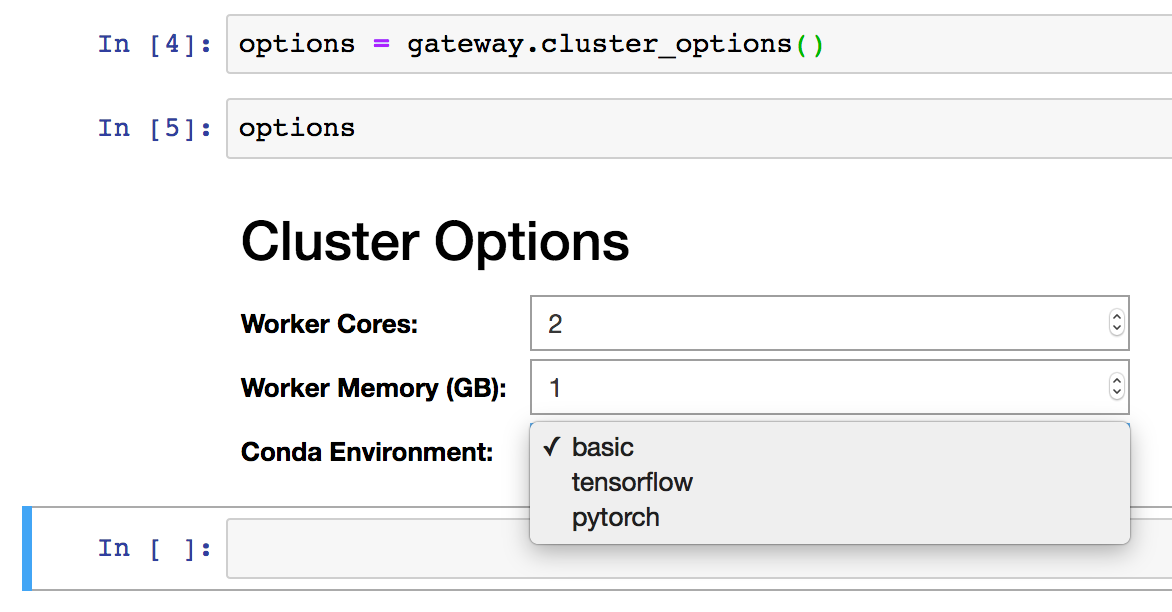Exposing Cluster Options
Contents
Exposing Cluster Options¶
By default cluster configuration (e.g. worker memory, docker image, etc…) is set statically by an administrator in the server configuration file. To allow users to change certain parameters when creating a new cluster an administrator must explicitly expose them in the configuration.
User Experience¶
On the user side, exposing options with allows users to:
Query what options (if any) are available using
dask_gateway.Gateway.cluster_options()
>>> options = gateway.cluster_options()
>>> options
Options<worker_cores=1, worker_memory=1.0, environment='basic'>
Specify configuration overrides for exposed fields as keyword arguments to
dask_gateway.Gateway.new_cluster()ordask_gateway.GatewayCluster().
# Using Gateway.new_cluster
>>> cluster = gateway.new_cluster(worker_cores=2, environment="tensorflow")
# Or using the GatewayCluster constructor
>>> cluster = GatewayCluster(worker_cores=2, environment="tensorflow")
If working in a notebook, use the ipywidgets based GUI to configure a cluster.

See Configure a cluster for more information on the user experience.
Server Configuration¶
Options are exposed to the user by setting c.Backend.cluster_options.
This configuration field takes either:
a
dask_gateway_server.options.Optionsobject, which describes what options are exposed to end users, and how the gateway server should interpret those options.a function which receives a
dask_gateway_server.models.Userand returns adask_gateway_server.options.Optionsobject when called. This supports dynamic configuration options that depend on the requesting user.
|
A declarative specification of exposed cluster options. |
A dask_gateway_server.options.Options object takes two arguments:
*fields: One or moredask_gateway_server.options.Fieldobjects, which provide a typed declarative specification of each user facing option.handler: An optional handler function for translating the values set by those options into configuration values to set on the corresponding ClusterConfig. Should have the signaturehandler(options)orhandler(options, user), whereoptionsis the validated dict of user options, anduseris aUsermodel for that user.
Field objects provide typed specifications for a user facing option. There
are several different Field classes available, each representing a
different common type:
|
An integer field, with optional bounds. |
|
A float field, with optional bounds. |
|
A boolean field. |
|
A string field. |
|
A select field, allowing users to select between a few choices. |
|
A mapping field. |
Each field supports the following standard parameters:
field: The field name to use. Must be a valid Python identifier. This will be the keyword users use to set this field programmatically (e.g."worker_cores").default: The default value if the user doesn’t specify this field.label: A human readable label that will be used in GUI representations (e.g."Worker Cores"). Optional, if not providedfieldwill be used.target: The target key to set in the processed options dict. Must be a valid Python identifier. Optional, if not providedfieldwill be used.
After validation (type, bounds, etc…), a dictionary of all options for a
requested cluster is passed to a handler function. This function is run on
the dask-gateway-server. Here any additional
validation can be done (errors raised in the handler are forwarded to the
user), as well as any conversion needed between the exposed option fields and
configuration fields on the backing ClusterConfig. The
default handler returns the provided options unchanged.
Available options are backend specific. For example, if running on Kubernetes, an options handler can return overrides for any configuration fields on KubeClusterConfig. See Cluster Backends for information on what cluster configuration fields are available for your backend.
Examples¶
Worker Cores and Memory¶
Here we expose options for users to configure
c.ClusterConfig.worker_cores and c.ClusterConfig.worker_memory.
We set bounds on each resource to prevent users from requesting too large of a
worker. The handler is used to convert the user specified memory from GiB to
bytes (as expected by c.ClusterConfig.worker_memory).
from dask_gateway_server.options import Options, Integer, Float
def options_handler(options):
return {
"worker_cores": options.worker_cores,
"worker_memory": int(options.worker_memory * 2 ** 30),
}
c.Backend.cluster_options = Options(
Integer("worker_cores", default=1, min=1, max=4, label="Worker Cores"),
Float("worker_memory", default=1, min=1, max=8, label="Worker Memory (GiB)"),
handler=options_handler,
)
Cluster Profiles¶
Instead of exposing individual options, you may instead wish to expose “profiles” - user-friendly names for common groups of options. For example, here we provide 3 cluster profiles (small, medium, and large) a user can select from.
from dask_gateway_server.options import Options, Select
# A mapping from profile name to configuration overrides
profiles = {
"small": {"worker_cores": 2, "worker_memory": "4 G"},
"medium": {"worker_cores": 4, "worker_memory": "8 G"},
"large": {"worker_cores": 8, "worker_memory": "16 G"},
}
# Expose `profile` as an option, valid values are 'small', 'medium', or
# 'large'. A handler is used to convert the profile name to the
# corresponding configuration overrides.
c.Backend.cluster_options = Options(
Select(
"profile",
["small", "medium", "large"],
default="medium",
label="Cluster Profile",
),
handler=lambda options: profiles[options.profile],
)
Different Options per User Group¶
Cluster options may be configured to differ based on the user by providing a
function for c.Backend.cluster_options. This function receives a
dask_gateway_server.models.User object and should return a
dask_gateway_server.options.Options object. It may optionally be an
async function.
Similar to the last examples, here we expose options for users to configure
c.ClusterConfig.worker_cores and c.ClusterConfig.worker_memory.
However, we offer different ranges depending on whether or not the user is a
member of the “power-users” group.
from dask_gateway_server.options import Options, Integer, Float
def options_handler(options):
return {
"worker_cores": options.worker_cores,
"worker_memory": int(options.worker_memory * 2 ** 30),
}
def generate_options(user):
if "power-users" in user.groups:
options = Options(
Integer("worker_cores", default=1, min=1, max=8, label="Worker Cores"),
Float("worker_memory", default=1, min=1, max=16, label="Worker Memory (GiB)"),
handler=options_handler,
)
else:
options = Options(
Integer("worker_cores", default=1, min=1, max=4, label="Worker Cores"),
Float("worker_memory", default=1, min=1, max=8, label="Worker Memory (GiB)"),
handler=options_handler,
)
c.Backend.cluster_options = generate_options
User-specific Configuration¶
Since the handler function can optionally take in the User object, you
can use this to add user-specific configuration. Note that you don’t have to
expose any configuration options to make use of this, the options handler is
called regardless.
Here we configure the worker cores and memory based on the user’s groups:
from dask_gateway_server.options import Options
def options_handler(options, user):
if "power-users" in user.groups:
return {
"worker_cores": 8,
"worker_memory": "16 G"
}
else:
return {
"worker_cores": 4,
"worker_memory": "8 G"
}
c.Backend.cluster_options = Options(handler=options_handler)